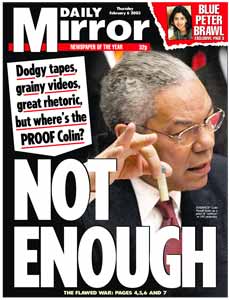
The Invasion of Kuwait

Fake Satellite Photos
"We could see clearly the main road leading right through Kuwait, south to Saudi Arabia, but it was covered with sand banks from the wind and it was clear that no army had moved over it. We could see empty barracks where you would have expected these thousands of troops to be billeted, but they were deserted as well."
Fake Dead Babies
Fake Statistics
A Grateful Nation

Like Father, Like Son

“Bush has repeatedly cited the 1988 gassing of Kurds in Halabja as evidence of Iraqi cruelty. Recently, Stephen C. Pelletiere, a former CIA analyst, has reminded us of a Defense Intelligence Study that concluded that (1) the Kurds were casualties in a battle for the city between Iraqi and Iranian forces and not the object of the attack; and (2) that it was the Iranian gas that killed the Kurds.
"I remember reading a story in The Washington Post about this report. Now, one of two things is inescapable: Either the U.S. government was lying when it issued the report, or the president and his people are lying today when they blame it on Iraq. It has to be one or the other.”

.........
Updates:Selected Bibliography
The Guardian UK 5 December 02
http://www.ppu.org.uk/iraq/scared.html
The Los Angeles Times 5 January 03
http://www.latimes.com/news/opinion/commentary/la-op-marshall5jan05,0,1013262.story?coll=la%2Dnews%2Dcomment%2Dopinions
The Independent Institute 7 October 1993
http://www.independent.org/tii/content/events/f_macarth.html
The Christian Science Monitor 6 September 02
http://www.csmonitor.com/2002/0906/p01s02-wosc.htm
Joe Vallis 12 January 03
http://homepage.ntlworld.com/steveseymour/wecontrolamerica/biowar.html
Business Week 5 February 2003
http://www.businessweek.com/bwdaily/dnflash/feb2003/nf2003026_0167_db052.htm
Mike Ruppert 5 February 03
http://www.fromthewilderness.com/free/ww3/100102_bush_advisors.html
SFGate.com 7 February 03
http://www.sfgate.com/cgibin/article.cgi?file=/news/archive/2003/02/07/international1107EST0556.DTL
The Independent 6 February 03
http://argument.independent.co.uk/commentators/story.jsp?story=375941
The New Hampshire Gazette (ongoing)
http://www.nhgazette.com/chickenhawks.html
Carl Jensen (ed.), 20 Years of Censored News, Seven Stories Press, © 1997, N.Y.
Haim Bresheeth and Nira Yuval-Davis (eds.), The Gulf War and the New World Order, Zed Books Ltd, © 1991, London and New Jersey

